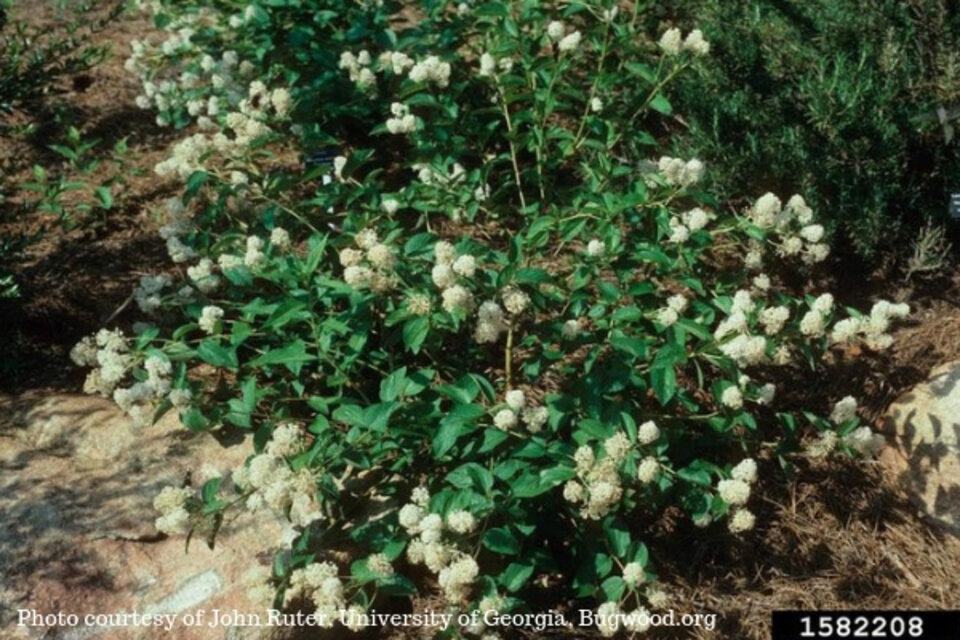Drought Tolerant Shrubs

Water conservation is important in home and business landscapes. While leaving automatic irrigation systems turned off, and only turning them on when plants need water, is a much needed practice change in many residential and business landscapes, selecting drought tolerant plants is also important.
This article focuses on drought tolerant shrubs for different functions. While listed as drought tolerant, keep in mind plants need established roots to develop tolerance to dry sites. It is often a deep or extensive root system that makes a plant drought tolerant.
The first year after planting provide adequate moisture without overwatering. Roots need water and oxygen in soil to grow and function well. Improving planting sites with double digging or tillage to loosen compacted soil, incorporating compost, and using a two to three inch layer of organic mulch placed on soil helps provide a good rooting environment.
When watering, moisten the soil eight inches deep within and outside of the planting hole; then allow the soil to dry slightly for oxygen recharge. If a drought tolerant shrub is selected and watered correctly the first year, it may not need watering again except during very dry conditions.
Now on to drought tolerant shrubs for Nebraska. There are many to choose from so I focused on shrubs that are not overplanted in our state and add value such as attracting pollinators, soil erosion control, or have edible fruit.
Almost all of the shrubs I list are flowering plants that can attract pollinators. Two especially good pollinator shrubs are New Jersey Tea (Ceanthus americanus) and blue beard (Caryopteris). New Jersey Tea grows 3 to 4 feet tall and wide with white, fragrant blooms from May to July. It is a tough plant for hard to grow areas.
Blue beard is known for bluish-purple blooms that last from late July into September. A time when few other shrubs bloom. As a blue flower, it is heavily visited by many types of bees. The shrub grows up to 3 feet tall and a little wider. The light green foliage has silvery undersides. This zone 5 plant will die back in hard winters and need pruning to remove the dead wood.
April blooming shrubs include clove currant (Ribes odoratum) and Nanking cherry (Prunus tomentosum). Clove currant grows 6 to 8 feet tall and wide. It can be a loose, open shrub with an unkempt look but tolerates poor soil, has yellow blooms with a clove like fragrance and the fruit, when produced, is edible. Nanking cherry is a very hardy shrub with red, cherry-like edible fruit. It grows 6 to 10 feet tall and wide.
A tough, low growing plant for erosion control is ‘Gro-Low” fragrant sumac (Rhus aromatic). It only grows 2 to 3 feet tall, but suckers out to 8 feet wide. It is a dense low growing shrub that will stabilize banks and grow in poor soil. The leaves and twigs are fragrant if bruised.
Not all Viburnums are drought tolerant but three that are include ‘Judd’ (Viburnum juddii), blackhaw (V. prunifolium) and ‘Mohican’ (V. lantana). They bloom in May with white blossoms and if there are other Viburnums nearby, they will produce ornamental fruit later in the season.
‘Judd’ and ‘Mohican’ grow up to 8 feet tall and 10 feet wide. Blackhaw viburnum will reach 15 feet in height and spread up to 12 feet. Viburnums are very tidy shrubs that hold their shape well.
Japanese kerria (Kerria Japonica) is a shrub for heavy shade. It has unique foliage and produces fairly large yellow blooms in April. A suckering shrub, kerria grows 5 to 10 feet tall and 10 feet or more wide. The cultivar ‘Picta’ only grows three feet tall and four feet wide. Root suckers can become a problem and may need to be removed to keep this plant in bounds. Or plant it for erosion control and it will do its job.
‘Pawnee Buttes’ western sandcherry (Prunus besseyi) is another low growing shrub reaching only two feet in height but up to six feet in spread. It has prolific white blooms in May and is eye catching when in bloom. It can develop dark red fall color during good fall color years. It is one of our native shrubs and if you have room for a low growing, spreading shrub, this one is worth a try.
This article was reviewed by Nicole Stoner